The Miniature Siberian Husky, also known as the Mini Husky, is a smaller version of the famous Siberian Husky breed. As the name suggests, this dog breed is a miniature version of the Siberian Husky.
Still, it retains many distinctive features and characteristics, including its striking appearance and energetic personality. Despite their smaller size, Miniature Siberian Huskies are known for their high energy levels and require regular exercise and stimulation to keep them happy and healthy.
With their playful and affectionate nature, these dogs make excellent companions for active families and individuals with plenty of time to spend with their pets.
A Brief Overview of Miniature Husky
| Size: | 13-17 inches |
| Weight: | 20-35lb |
| Lifespan: | 12-14 years |
| Coat: | Medium length double coat |
| Color: | Many different colors and mixes of whites, blacks, red, brown, and sable |
| Do They Shed: | Yes |
| Temperament: | Mischievous, loyal, and outgoing |
| Intelligence: | High |
| Socialization: | Independent but very social with both people and other dogs |
| Destructive Behavior: | Gets destructive if bored and not exercised properly |
| People Skills: | They can be stubborn but friendly |
| Good with Children: | Yes |
| Activity Levels: | Very high energy levels |
What is a Miniature Husky?
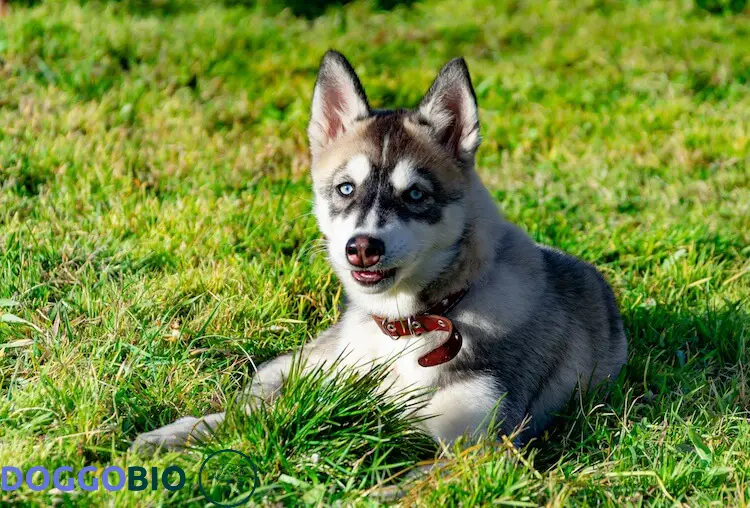
The Miniature Husky is a distinct breed, not to be confused with the Alaskan Klee Kai. Bree Normandin created this breed by mating smaller Siberian huskies. Though they’re companion dogs, they’re classified as working dogs due to their standard husky ancestry, which was bred for transporting loads. Despite their size, Miniature Huskies retain the energy and intelligence of their larger counterparts.
History of Miniature Husky
The Miniature Husky Siberian belongs to the same breed as the Siberian Husky. Both these breeds share a common history and genetics.
Regarding taxonomy, the Miniature Husky and the Siberian Husky fall under the Spitz family of dogs. A dense, double coat, perky ears, and an appearance reminiscent of a wolf characterize this family of canines.
Siberian Huskies trace their origin back to northeast Asia, where the Chukchi people of Siberia initially developed them. The Miniature Husky shares the same origin story as a subcategory of this breed. The Siberian Husky is believed to be descended from the Taimyr wolf of north Asia and maintains a close genetic kinship with the Alaskan Malamute and Alaskan Husky.
The Difference Between a Miniature Husky And Regular Husky
The answer to this problem is rooted in a critical difference between the two breeds: their size. The Miniature Husky is notably smaller than its Regular Husky counterpart, measuring an average of 12 to 17 inches in height. In stark contrast, the Regular Husky stands tall, measuring approximately 20 to 24 inches.
| Miniature Husky | Regular Husky | |
| Purity | Purebred | Purebred |
| Purpose | Companion dog | Companion or working dog |
| AKC Recognition | No | Yes |
| Size | Small | Medium |
| Weight | 15 – 35 pounds | 35 – 60 pounds |
| Height | 12 – 17 inches | 20 – 24 inches |
| Coat Colors | Black & White, Silver, Sable, Gray, White, Red & White | Black, Gray, Black & White, Agouti & White, Red & White |
| Origin | USA | Siberia |
| Lifespan | 12 – 15 years | 12 – 15 years |
| Personality | Playful and sociable | Friendly and sociable |
| Price | $1,250 – $1,600 | $700 – $1,200 |
Interesting Facts You Need To Know
Let’s unleash some fun facts about the Miniature Siberian Husky that you might not know yet!
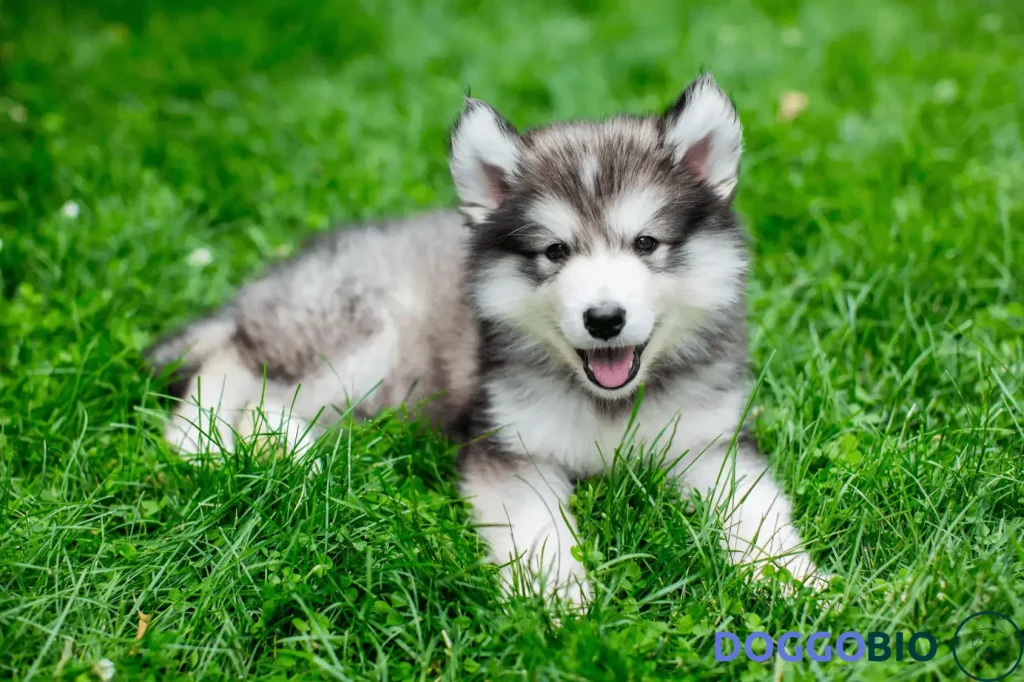
1.Eye on the Prize
Did you know that Husky’s almond-shaped eyes allow them to squint and keep snow out of their eyes? This helps them navigate through snowy terrains and avoid discomfort.
2.Escape Artists Extraordinaire
Miniature Siberian Huskies are known to be outstanding escape artists. They are cunning and persistent, making it quite a task to keep them contained.
3.The Blues eyes
One of the few dog breeds with piercing blue eyes, Huskies are a sight to behold. Their striking gaze can leave you in awe, whether it’s one or two.
4.Cold Weather Warriors
Due to their double coats, Miniature Siberian Huskies can withstand freezing weather. Their thick fur keeps them warm and comfortable in the harshest of winters.
5.Howl
Miniature Siberian Huskies are a very vocal breed and love to howl. Whether to communicate with their pack or just for the sheer fun of it, their howls can be heard from a distance.
What Does a Miniature Husky Look Like?
The appearance of the Miniature Husky is similar to that of the Standard Siberian Husky except for its size. One thing that Huskies are known for is heterochromia, which is a striking feature where one eye is a different color from the other. Additionally, their ears are always erect and alert, and a brush tail is present.
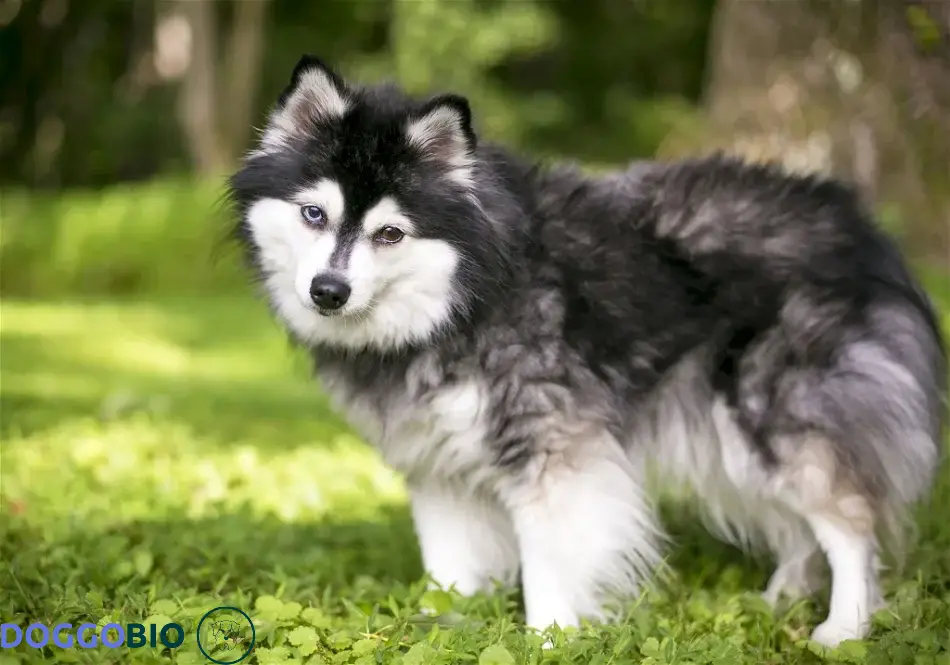
Size, height, and weight
In terms of size, males should stand between 14-17 inches tall and weigh 25-35 pounds, while females should stand between 13-16 inches and weigh 20-30 pounds. However, despite their smaller size, their stoutness and body proportion are similar to the Standard Husky.
It’s important to note that Miniature Huskies with disproportionate limbs and larger heads due to the presence of the dwarf gene cannot be considered Mini Huskies.
1.Mini teacup Husky
The term “Miniature Teacup Husky” is misleading. Typically, “teacup” refers to dogs weighing 5 pounds or less at maturity. However, Mini Huskies usually weigh around 20 pounds when fully grown. It’s not genetically feasible to breed a true “teacup” Mini Husky.
Instead, Miniature Siberian Huskies are an established breed with distinct traits. When choosing a pet, prioritize compatibility over size or trends.
2.Mini toy Husky
The Mini Toy Husky, sometimes termed Toy Miniature Siberian Husky, falls within the height range of toy breeds, standing 13 to 17 inches tall. Though “toy” describes both this Husky and toy breeds like the Miniature Pinscher, they differ in weight. Toy breeds weigh 5 to 15 pounds, while a Mini Husky can reach 35 pounds. Originating from the smallest puppies over generations, the Mini Toy Husky lacks an official breed standard and isn’t recognized by major kennel clubs.
3.Micro Husky full grown
A Micro Husky, often called a Mini Siberian Husky, is a downsized version of the Siberian Husky. While some might use “midget Husky,” it’s distinct from a dwarf Siberian Husky.
Mini Siberian Huskies are healthy and proportionate, bred from smaller specimens over generations. Despite their size, they maintain the Siberian Husky’s iconic look and temperament, offering a compact alternative for enthusiasts.
Coat colors and types
These mini pups come in the same coat colors as standard Siberian Huskies. They can be in any color variation between white and black, including red, brown, and sable. It is not uncommon for mini Huskies to have unusual markings or patterns on their face and body.
Since they thrive in the cold snow, they have a double coat. The coat is medium in length with a soft and dense undercoat. It should be noted that the undercoat is what the mini Husky will shed during the shedding season. Outside of their shedding season, they still shed quite a bit throughout the year and require regular weekly brushing.
1.The Mini White Husky
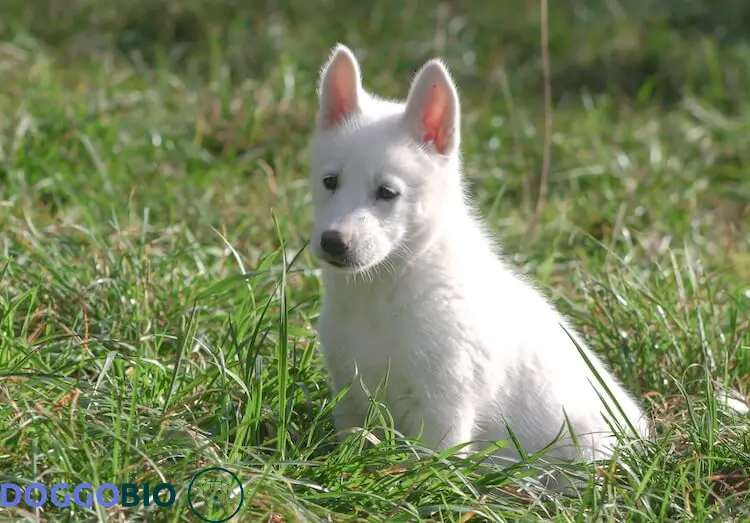
The Mini White Husky is a distinctive variant of the Mini Husky breed, characterized by its pure white coat, black accents on the nose, paws, and eye rims. Some may exhibit a pink “winter nose.” Their unique color results from both parents carrying a recessive white-coat gene, making them rare.
They shouldn’t be mistaken for albino or Isabella Huskies. Born with blue eyes, these may shift to brown by two months, though many retain blue or even bi-colored eyes.
Like other Mini Huskies, they have a double coat suited for cold climates, and their black eye rims help reduce snow glare.
2.The Mini Brown Husky
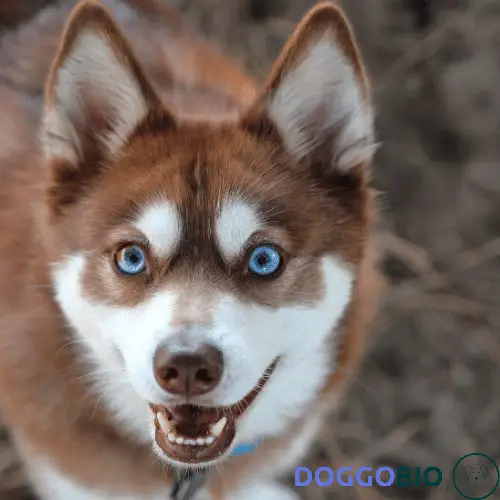
The Mini Brown Husky, part of the Miniature Husky breed, boasts a range of brown shades in its coat, from light tints to deep chocolates.
Some may have white markings, but all-brown variants are rare, much like their all-white or all-black counterparts. Typically, they have brown eyes, but variations like hazel or blue, and even heterochromia, can occur.
3.The Mini Red Husky

The Red Mini Husky is a unique variant of the Miniature Husky, showcasing a vibrant red coat that can range from light to deep copper. Some may have combinations of red with white or black. These huskies often have a white underbelly, liver-colored paws and nose, and can sport brown, blue, or bi-colored eyes. They come in three coat lengths: medium, woolly, and short, with the woolly type being the fluffiest.
4.The Mini Black Husky
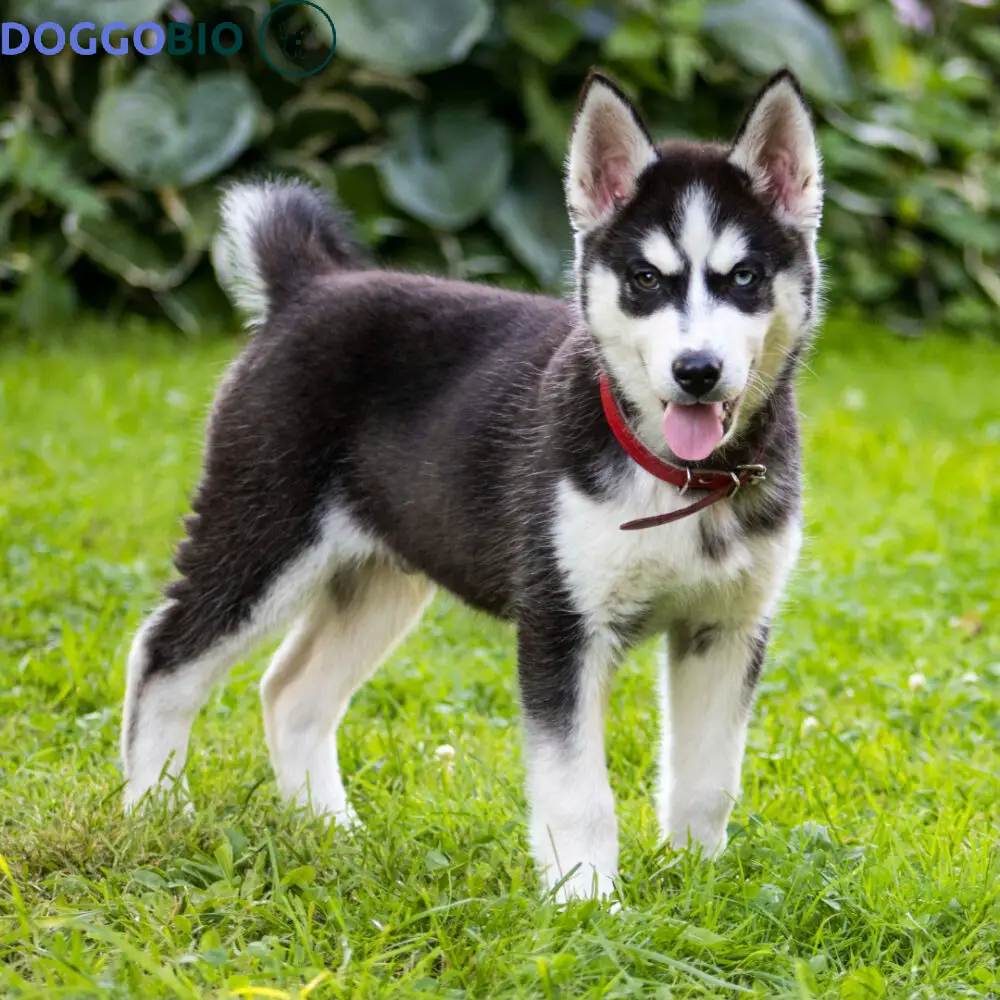
The Mini Black Husky is a captivating variant of the Miniature Husky. While all-black versions are rare, many have white markings due to the piebald gene, appearing on the chest, legs, paws, or face. Regardless of color variations, they retain the typical Mini Husky traits, including a double-layered coat suited for cold climates and distinctive black eye rims.
Temperament and Personality
The Miniature Husky is a fluffy ball of energy with a quirky temperament that may leave you scratching your head. While generally loving and gentle, they can also be independent-minded and stubborn.
This can lead to some interesting situations, like when your Miniature Husky decides to run away from home in search of adventure.
However, with early training and a firm hand, you can keep your Miniature Husky’s temperament in check and ensure they are well-behaved members of your household. Despite their headstrong nature, these dogs are friendly and social with everyone they meet, including house guests and other dogs.
Is Miniature Husky a good fit for families?
Miniature Huskies are great family pets due to their social nature and playful personality. They enjoy the attention and thrive when surrounded by their loved ones. However, it is essential to supervise more minor children during playtime to prevent any rough accidents.
These adorable canines also get along well with other pets, particularly those they have grown up with. As pack animals, they love the company of other dogs but have a high prey drive that may lead them to chase smaller animals like cats or rabbits.
One of the most endearing traits of Huskies is their ability to communicate with their owners through vocalization. They use whining, screaming, and howling to express their needs and wants. This is what makes them stand out and be loved by many. Mini Huskies are known for their talkative nature, but surprisingly, they hardly ever bark.
Although not aggressive, they may have a stubborn streak that can challenge training. But with patience and positive reinforcement, Mini Huskies can be trained effectively. These cute and friendly dogs make excellent pets for anyone looking for a loyal and loving companion.
Does Miniature Husky Bark A Lot?
The Miniature Siberian Husky is not a breed that is known for constant barking. They are not particularly aggressive and are not the best choice for guard dogs. In fact, if an intruder were to enter your home, it’s more likely that a Miniature Husky would greet them warmly rather than bark at them.
However, it’s worth noting that these dogs, much like their wolf ancestors, have a penchant for howling. This can sometimes disrupt peaceful evenings, so it’s essential to train them to control their vocalizations.
Training
Get ready for an exciting journey of training your Mini Husky! This intelligent breed has a stubborn streak, so it’s crucial to start teaching them as early as 7 to 8 weeks old. Don’t let their adorable looks fool you – they can easily dominate you if you don’t take charge from the beginning.

1.Potty Guide
The first step in training is to establish a designated spot for your furry friend to do their business. This designated spot should be easily accessible and always available for them to use.
It’s essential never to scold your Mini Husky puppy when they accidentally soil the floor. Instead, remain calm and patient with them. One effective method is to take them to their designated spot at a particular time, such as after meals or after they wake up.
Positive reinforcement is critical when it comes to potty training. Praise your Mini Husky immediately after they do business in the designated spot.
Once your Mini Husky has successfully used their designated spot, remove them from the area and avoid letting them play or linger in that area. This helps them understand that the site is solely for doing their business. With patience, consistency, and positive reinforcement, your Mini Husky will soon become a potty-trained pup!
2.Walk on leash
Leash or harness walking can be tricky when it comes to Miniature Huskies. As sled dogs, they have a strong urge to pull on the leash and lead you on walks. To prevent any potential harm or discomfort to their necks, it’s better to use a harness instead of a collar.
Starting early is the key to successful leash training. Begin by allowing your Mini Husky to get used to the collar, then attach the leash and take them out for a walk. When they begin to take control and pull on the leash, stop walking and stand still until they calm down. Once they settle, reward them for their excellent behavior.
It’s essential to remain consistent with your leash training and gradually increase the duration and distance of your walks. Before long, your Mini Husky will be a pro at walking on a leash or harness.
3.Start with basic commands.
The Mini Husky is intelligent, and teaching them basic commands is crucial for their mental development and behavior. But here’s the catch: they can be stubborn, challenging training.
But fret not because positive reinforcement is the key to success. Forget about food rewards – most Mini Huskies need to be food-motivated. Instead, offer them a good rub or a play session with their favorite toy to keep them engaged.
Now, let’s move on to the basic commands:
- Sit, Come, Stay, and Down.
- When teaching your Mini Husky to sit, place your hand above its head and push down gently while saying the command.
- Repeat until they do it consistently.
For the Come command, hold your hand and say the word while backing away from them once they catch up, praise and reward them with a friendly pat or playtime.
To teach Stay, start with the Sit command, then step back and say the word while holding up your hand. Please wait a few seconds, then return to them and reward them.
And finally, for the Down command, ask your Mini Husky to sit, then hold a treat in front of them and lower it to the ground while saying the order. Once they lie down, reward them and repeat until they get the hang of it.
4.Socialization
Socializing your Mini Husky is a critical aspect of its development. This involves exposing them to different people, pets, sights and sounds at an early age. Failure to do so can lead to a dog that is easily overwhelmed and uncomfortable around strangers when they get older.
The key to successful socialization is gradual exposure to various stimuli. Start with simple things like introducing them to new people or pets in a controlled environment. Gradually increase the complexity of these interactions until your Mini Husky becomes comfortable around different people, pets, and situations.
Remember to reward your puppy for good behavior during socialization to reinforce positive associations with new experiences. With proper socialization, your Mini Husky will be able to react to the world around them healthily and positively.
Exercise Requirements
The exercise requirements for adult Mini Husky breeds are non-negotiable. They must be exercised for at least one hour daily to burn off their excess energy. This is the same for the standard Husky breed, as they are highly active dogs that enjoy running around and playing.
When Mini Huskies are puppies, the amount of exercise they need is calculated by multiplying their age in months by 5 minutes. For instance, a four-month-old Mini Husky should ideally have 20 minutes of playtime daily. However, puppy exercises should be limited to light walking and playing to avoid damaging their developing bones and joints.
As Mini Huskies mature, their exercise routine can be gradually increased. Besides physical activities, mental exercises like challenging games can build confidence and reduce boredom.
A few physical and mental exercises you can do with your Mini Husky are playing hide-and-seek, frisbee throwing, and an agility game that involves weaving in and out of cones or running through a portable chute tunnel.
For senior Mini Huskies, reducing the time spent going for walks and avoiding taking them for runs is essential. Although they may tire out much more quickly, they still need a little daily exercise to stimulate them physically and mentally.
Grooming and Cleaning
These northern sled dogs have a thick, double coat that insulates them against the cold and protects them from the sun. But this also means that they shed a lot of hair, making them unsuitable for people with allergies and those who don’t fancy a lot of vacuuming.
You’ll need to brush their coat several times weekly to keep it in good condition. And remember that they will shed heavily twice a year when they swap their winter coat for a lighter summer coats.
While daily grooming can help minimize shedding, it’s not a foolproof solution. But don’t even think about giving your Miniature Husky a haircut. Their coat protects them throughout the year, insulating them in winter and safeguarding them from the sun in summer.
Miniature Huskies are considered one of the cleanest dog breeds despite the shedding. They won’t stink up your house with doggy odors and don’t require frequent baths since they groom themselves, sometimes even cat-like.
| rooming Needs | Grooming Frequency |
| Hair Brushing | 1 to 2X weekly. |
| Bathing | Once a month. |
| Nail Trimming | As needed. |
| Teeth Brushing | 3 to 4X per week. |
Is Miniature Husky Hypoallergenic?
No, Miniature Huskies is not hypoallergenic.
Despite their smaller size compared to standard Huskies, Miniature Huskies are not considered hypoallergenic. They shed significantly throughout the year, making them less suitable for those with allergies. It’s a misconception that loose hair is the main allergen; in reality, dander and dried saliva attached to the hair are the primary triggers for allergic reactions.
People with sensitivities to dog allergies might experience symptoms like a runny or stuffy nose, itchy eyes, breathing issues, asthma flare-ups, and skin rashes when around a Mini Husky.
If you’re set on having a Miniature Husky and are concerned about allergies, there are measures you can take to reduce allergen exposure. However, it’s crucial to understand that no dog breed is entirely hypoallergenic. When thinking about getting a Mini Husky, it’s essential to evaluate the potential risks and benefits thoroughly.
Food and Diet
When it comes to feeding your miniature Husky, it’s important to remember that they’re not your typical lap dog that can exist on just a few kibbles and bits. These energetic pups require a diet that can keep up with their high energy levels.
The ideal diet for these dogs is low in fat and carbohydrates and high in protein, preferably from meat sources. This doesn’t necessarily mean a raw diet but rather a diet tailored to their nutritional needs.
But before you go ahead and start experimenting with different types of dog food, it’s always best to consult your veterinarian. They can advise on what food is best for your furry friend.
When monitoring their growth, remember that adult males should weigh between 25-35 pounds, while females should weigh between 20-30 pounds. So, make sure to keep an eye on their weight and adjust their diet accordingly if needed.
Common Health Issues
It is worth noting that although Miniature Huskies are bred from runts, they are typically a healthy breed. However, they are still susceptible to health issues affecting other dog breeds and their standard Husky counterparts.
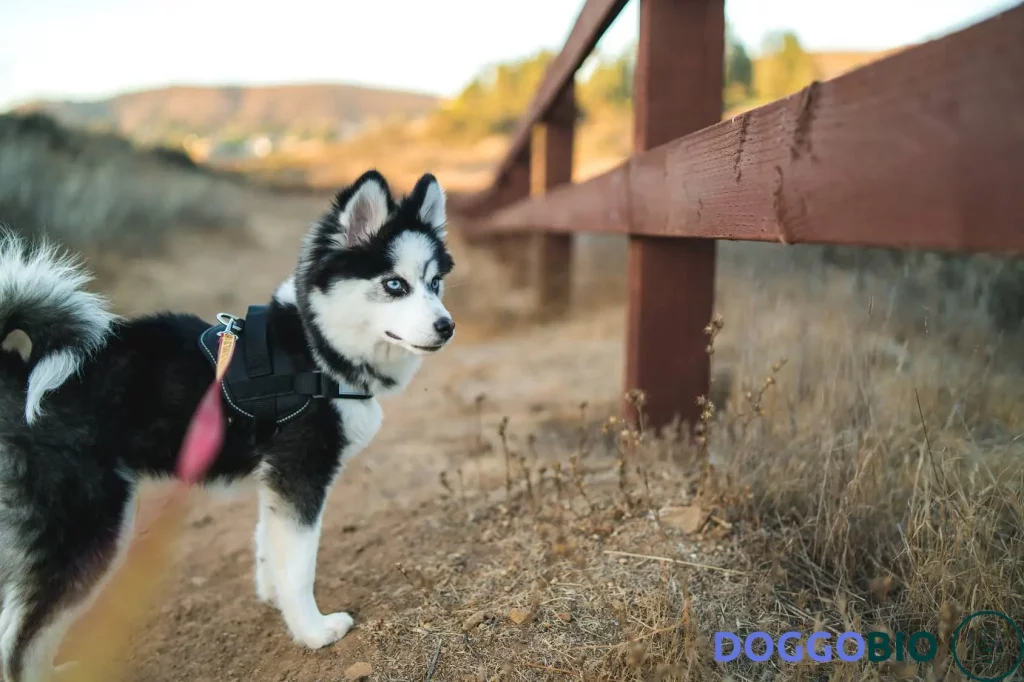
1.Hip Dysplasia
Hip dysplasia, a skeletal disorder that causes the hip joints to become deformed and unstable, is a common health issue that Miniature Huskies may develop. It’s not just a problem that affects older dogs; young puppies may also develop this condition.
The signs of hip dysplasia may include limping, difficulty jumping or standing, weakness and pain in the legs, lameness, and cracking sounds from the joints. These symptoms can cause your Miniature Husky to feel discomfort and pain, making it challenging for them to move around.
Sadly, hip dysplasia has no absolute cure, but some treatments can help manage the condition. Oral joint supplements and proper weight management can ease symptoms and reduce discomfort. However, surgery may be recommended for severe cases.
2.Hypothyroidism
Hypothyroidism is a disorder that affects the thyroid gland and results in low levels of thyroid hormones that play a vital role in the body’s metabolic process.
This condition can lead to hair loss, dry skin, weight gain, lethargy, and intolerance to cold temperatures, among other symptoms.
Miniature Huskies are given lifelong thyroid hormone replacement therapy to manage hypothyroidism, typically drugs containing levothyroxine and sodium. However, dogs can still enjoy everyday, healthy lives with proper treatment.
3.Eye problems
Huskies are prone to canine cataracts and corneal dystrophy, two common eye problems. Cataracts cause the cornea to become cloudy and are often hereditary, but they can also be caused by trauma, diabetes, or nutritional imbalance.
Corneal dystrophy is also an inherited disease that results in corneal opaqueness. Signs of corneal dystrophy include light sensitivity and excessive blinking. Treatment includes antibiotic eye medication and sometimes surgery.
4.Follicular Dysplasia
Follicular dysplasia is a genetic condition affecting the hair follicles of Mini Huskies, causing abnormal hair growth and loss. The state may also lead to dry and scaly skin, causing itchiness and excessive scratching.
Currently, there is no cure for this disease. However, it can be managed using dog shampoos that can alleviate the dryness of the skin. It is essential to consult with a veterinarian to determine the best course of treatment for your Mini Husky.
5.Zinc Deficiency
Zinc deficiency is a condition that can occur due to either malabsorption or improper digestion of the mineral. Maldigestion happens when the mineral can’t be broken down in the intestines, while malabsorption occurs when it doesn’t get passed into the blood.
When a Mini Husky suffers from this deficiency, signs of the condition may manifest, such as stunted growth, diarrhea, dried footpads, and hair loss.
To treat the condition, a veterinarian may prescribe zinc supplements, which can help restore the mineral levels in the body. However, the deficiency can lead to more severe health issues without proper treatment, so seeking professional help is essential if any symptoms are noticed.
How Long Does a Miniature Husky Live?
The lifespan of a Miniature Husky is generally about 12 to 14 years, similar to that of a standard Siberian Husky. However, a dog’s lifespan can be affected by several factors, such as nutrition, exercise, and regular health checkups.
A well-balanced diet and regular exercise can help improve a Miniature Husky’s lifespan. It is also essential to schedule regular vet visits to monitor the dog’s health and ensure early detection of any health issues.
As dogs age, their physical abilities and sensory organs may weaken, so it is essential to make certain modifications in the household to make it safe for them. You can ensure your furry companion’s long and healthy life by taking good care of a Miniature Husky.
How Much Is The Price of a Miniature Husky?
The price range for a Miniature Husky pup may vary depending on several factors, such as the breeder’s location, pedigree, and demand. On average, the price tag for a Miniature Husky may set you back around $1500, but some breeders may charge up to $5000 for a purebred Miniature Husky.
However, it is essential to note that the cost of owning a Miniature Husky extends beyond the initial purchase price, as expenses such as food, toys, grooming, and veterinary care should also be considered.
Is Miniature Husky Right For Me?
Are you a go-getter enjoying long strolls and breaking a sweat? If so, the Miniature Husky may be the breed for you! While they are pretty energetic, they are also highly adaptable and can thrive in almost any living situation due to their diminutive size.
List of dogs that are similar to Miniature Husky
- Husky-Dalmatian Mix
- Husky-French Bulldog Mix
- Husky-Doberman Mix
- Husky-Rottweiler Mix
- Husky-Pug Mix
- Husky-Yorkie Mix
- Husky-Greyhound Mix
- Husky-St Bernard Mix
- Husky-Great Dane Mix
- Husky-Cane Corso Mix
- White Husky
- Husky-Chihuahua Mix
- Husky-Blue Heeler Mix
Frequently Asked Questions
1.Is Miniature Husky Shed A Lot?
The answer is yes! This energetic pup sheds his soft undercoat throughout the year and sheds even more heavily in the fall and spring when he blows his coat to adapt to the changing temperatures. And if you live in a warm climate, the shedding could be even more intense.
2.Is Miniature Husky easy to train?
The Miniature Husky is a breed that packs a big punch, thanks to their intelligence and boundless energy. However, they also have a stubborn streak that makes training challenging, especially for inexperienced owners.
3.What is another name for Miniature Husky?
A small-sized version of the Siberian Husky, the Miniature Husky has been given many names, including the Miniature Siberian Husky dog breed or simply Mini Husky.
Conclusion
In conclusion, the Miniature Siberian Husky is a delightful breed that offers all the best qualities of the Siberian Husky but in a smaller package. With their striking appearance, energetic personality, and affectionate nature, Miniature Siberian Huskies make lovely pets for active families and individuals who have the time to provide them with the care and attention they require.
However, like any breed, it is essential to thoroughly research and understand the Miniature Siberian Husky’s needs before deciding to bring one into your home. With the proper care and attention, these dogs can be loyal and loving companions for many years.

Pingback: Chihuahua Husky Mixes: Deep Into The Interesting World 2023
Pingback: St Bernard Husky Mix: Unveiling the Interesting Secrets 2023
Pingback: Husky Pug Mix: Unveiling the Magic of This Breed 2023
Pingback: White Husky: Dive into the Fantastic World of This Breed 2023